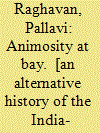| Srl | Item |
| 1 |
ID:
170546


|
|
|
|
|
| Publication |
Noida, HarperCollins Publishers, 2020.
|
| Description |
xii, 247p.hbk
|
| Standard Number |
9789353572730
|
|
|
|
|
|
|
|
|
|
|
|
Copies: C:1/I:0,R:0,Q:0
Circulation
| Accession# | Call# | Current Location | Status | Policy | Location |
| 059832 | 327.54091/RAG 059832 | Main | On Shelf | General | |
|
|
|
|
| 2 |
ID:
146841


|
|
|
|
|
| Summary/Abstract |
In January 1950, Jawaharlal Nehru wrote to Liaquat Ali Khan, seeking a joint declaration of a No War Pact by the governments of India and Pakistan. The two prime ministers undertook a lengthy correspondence on this subject, spanning a year that saw rising levels of resentment and hostility between the two countries. Yet, as the inter-dominion correspondence on the No War declaration during this period shows, neither government was actually predisposed to take a belligerent position and critically engaged with the possibility of signing a declaration that renounced the use of war. As I hope to show through my discussion of the ‘No War Pact’ correspondence, relations between India and Pakistan were not necessarily confined to hostile exchanges, and both governments also repeatedly engaged with each other to attempt to find spaces of agreement and compromise. Although much of the existing literature on India–Pakistan relations characterizes it as locked in acrimony and conflict, which arose from the bitterness of partition, a closer scrutiny reveals a more nuanced picture. Attempts at cooperation and dialogue between the two governments—and the rationale for undertaking them—complicate our understanding of a relationship apparently limited to instinctive antagonism, and help in creating a more rounded picture of the India–Pakistan dynamic.
|
|
|
|
|
|
|
|
|
|
|
|
|
|
|
|